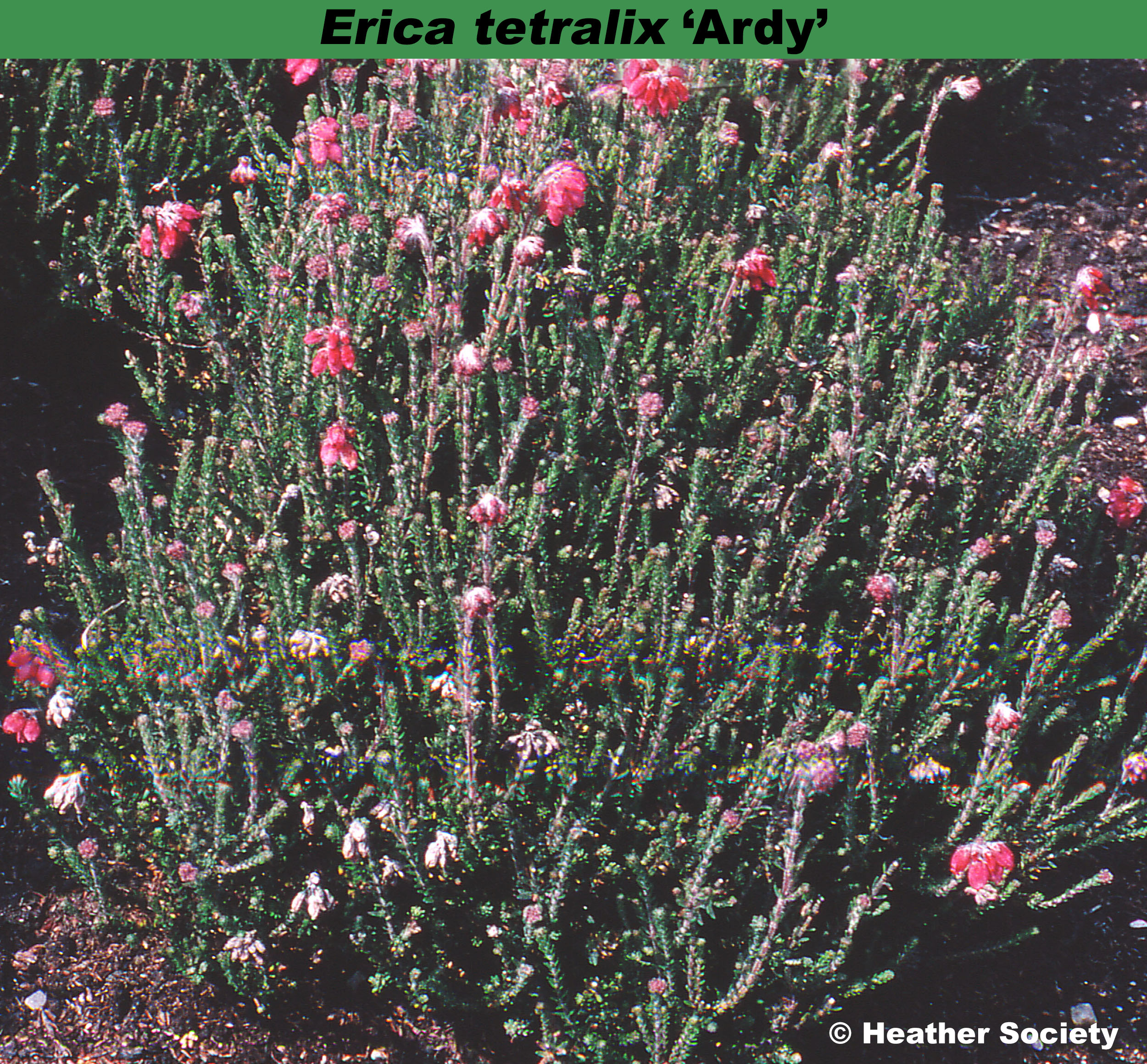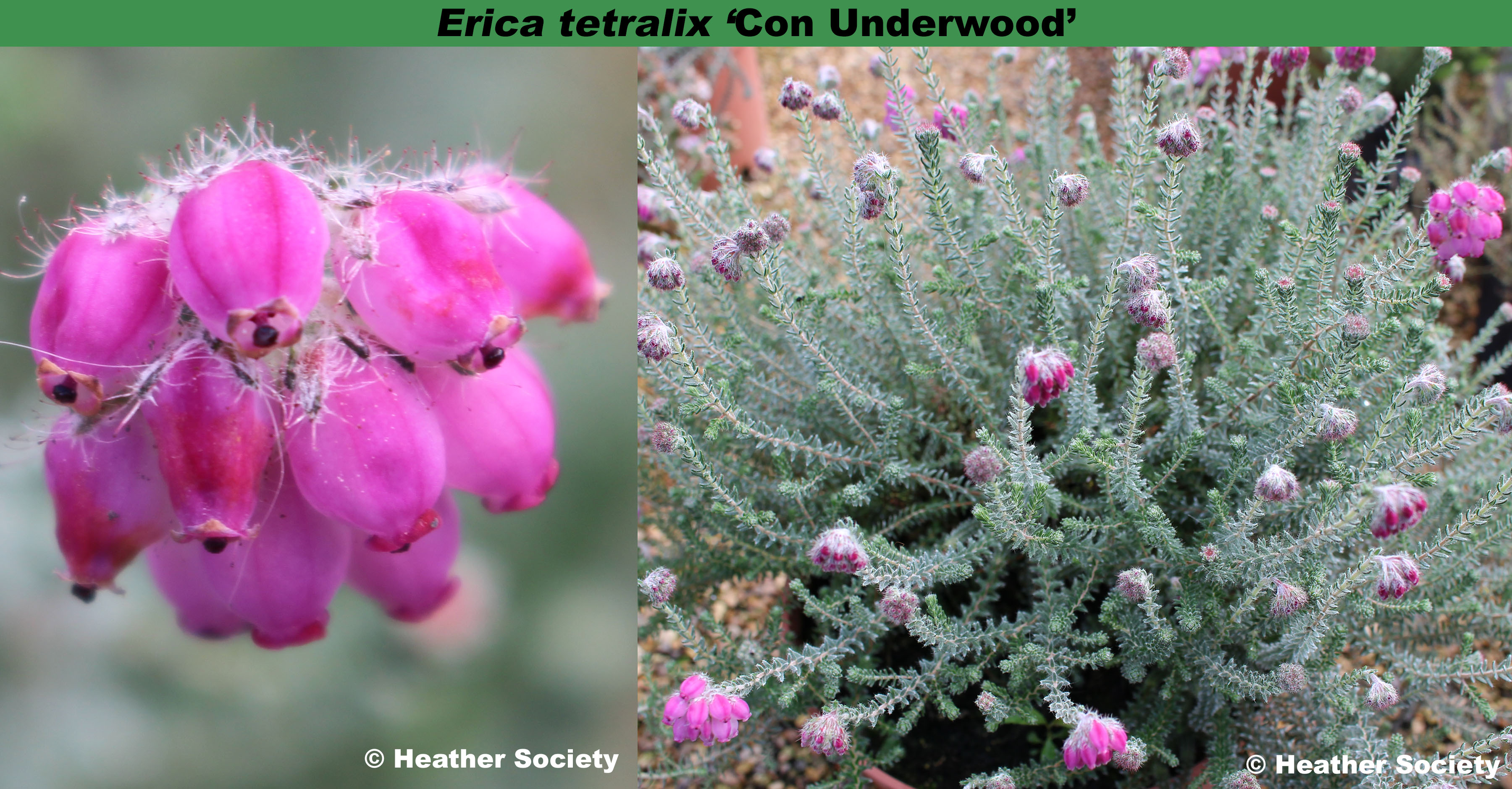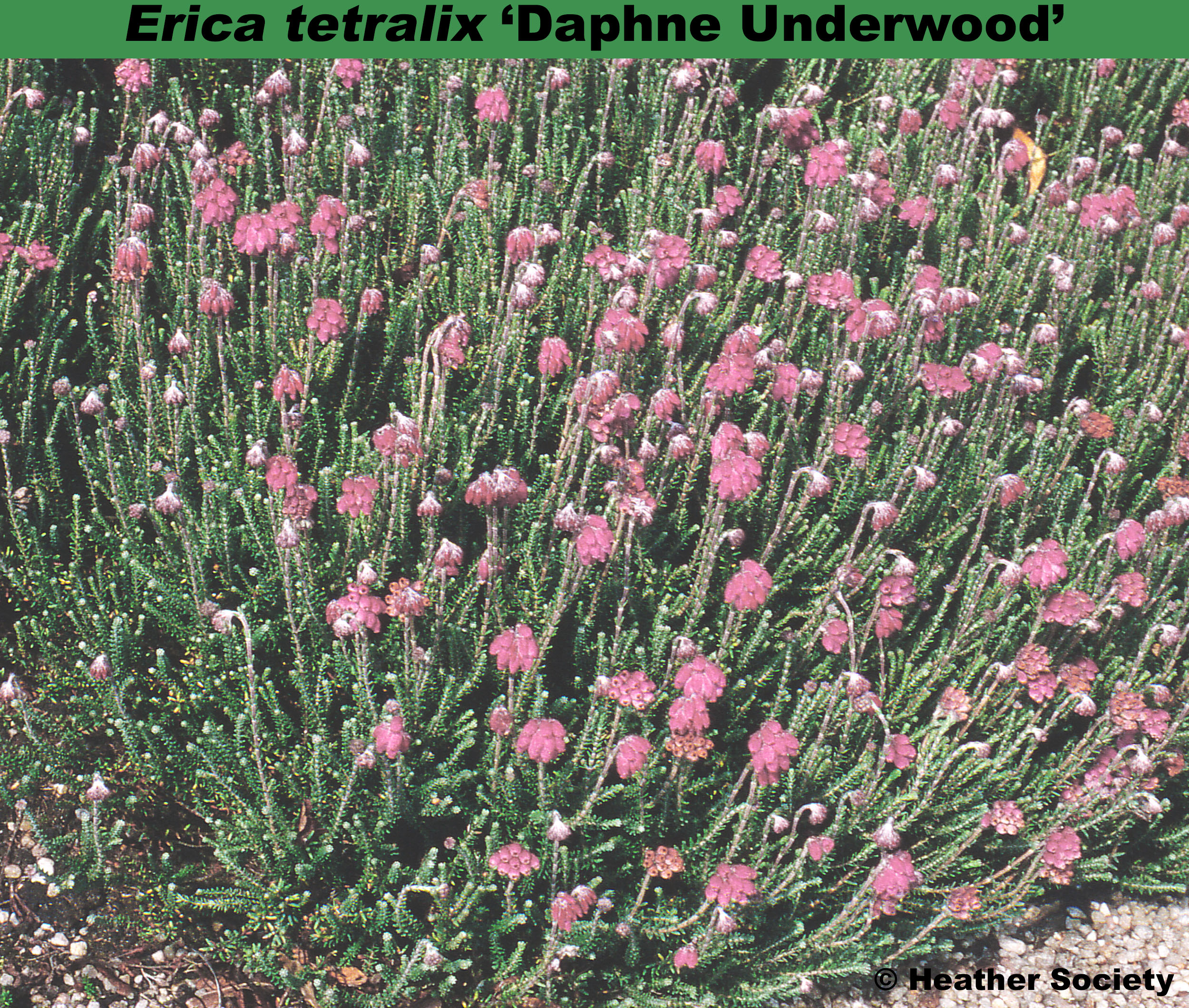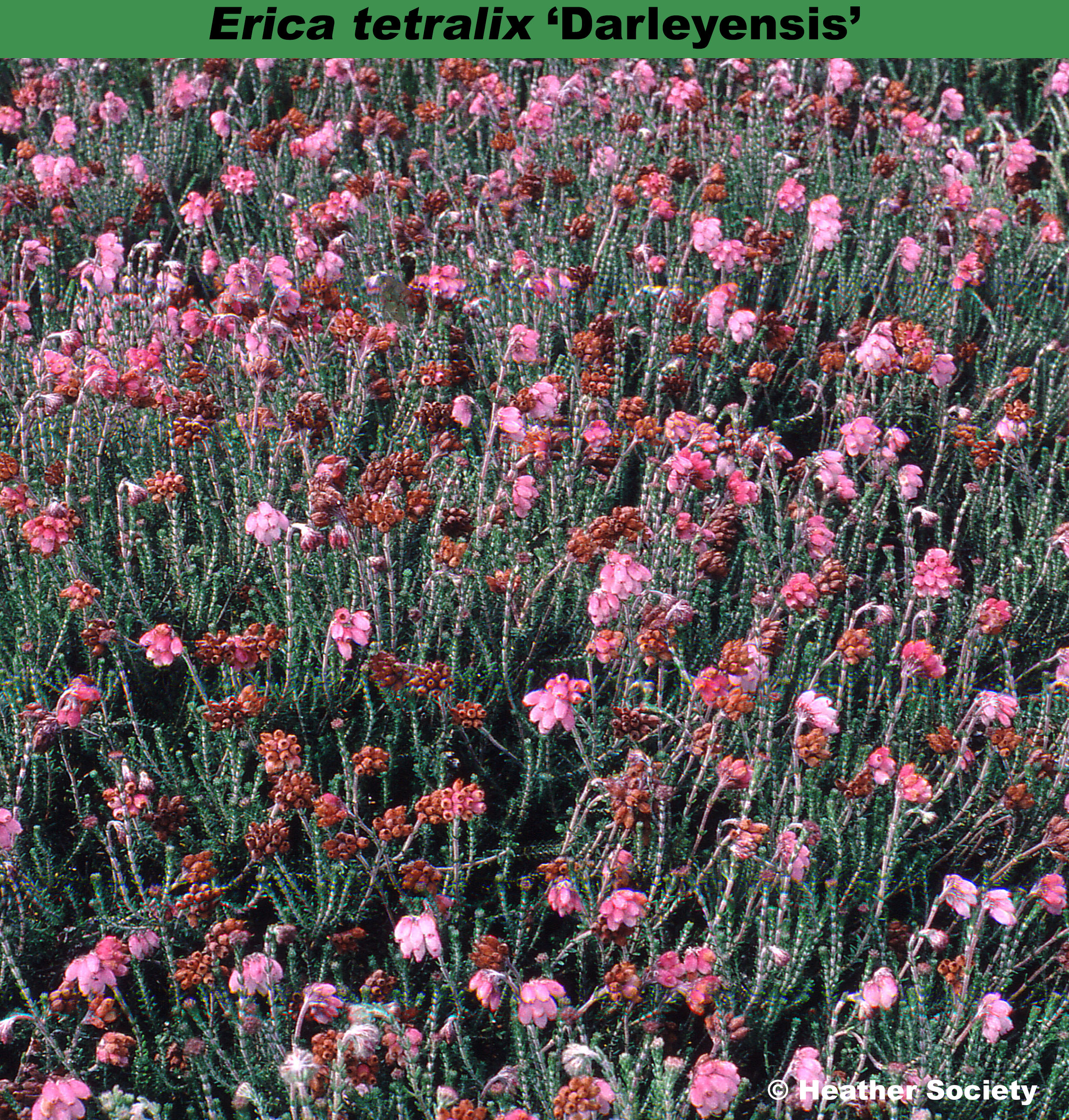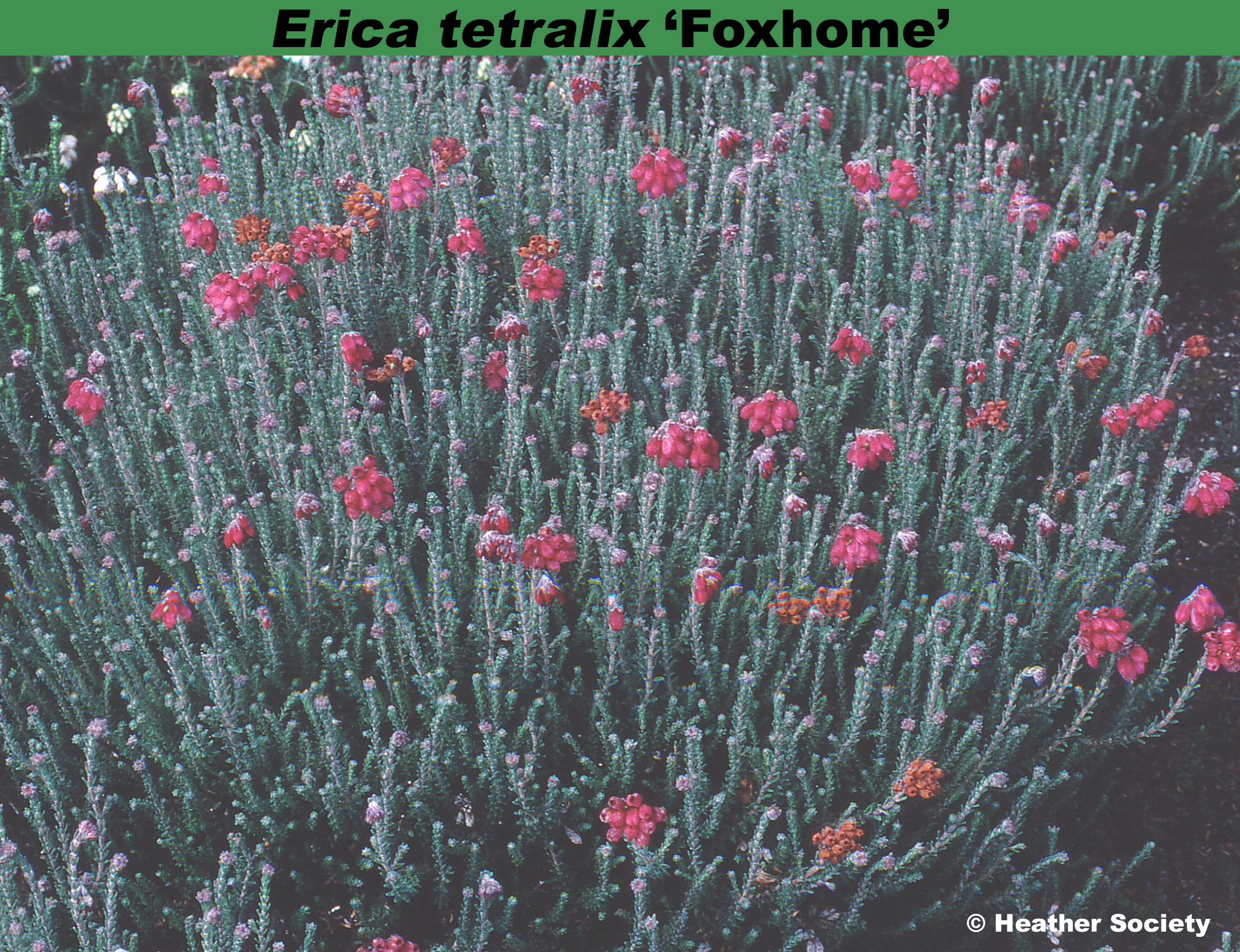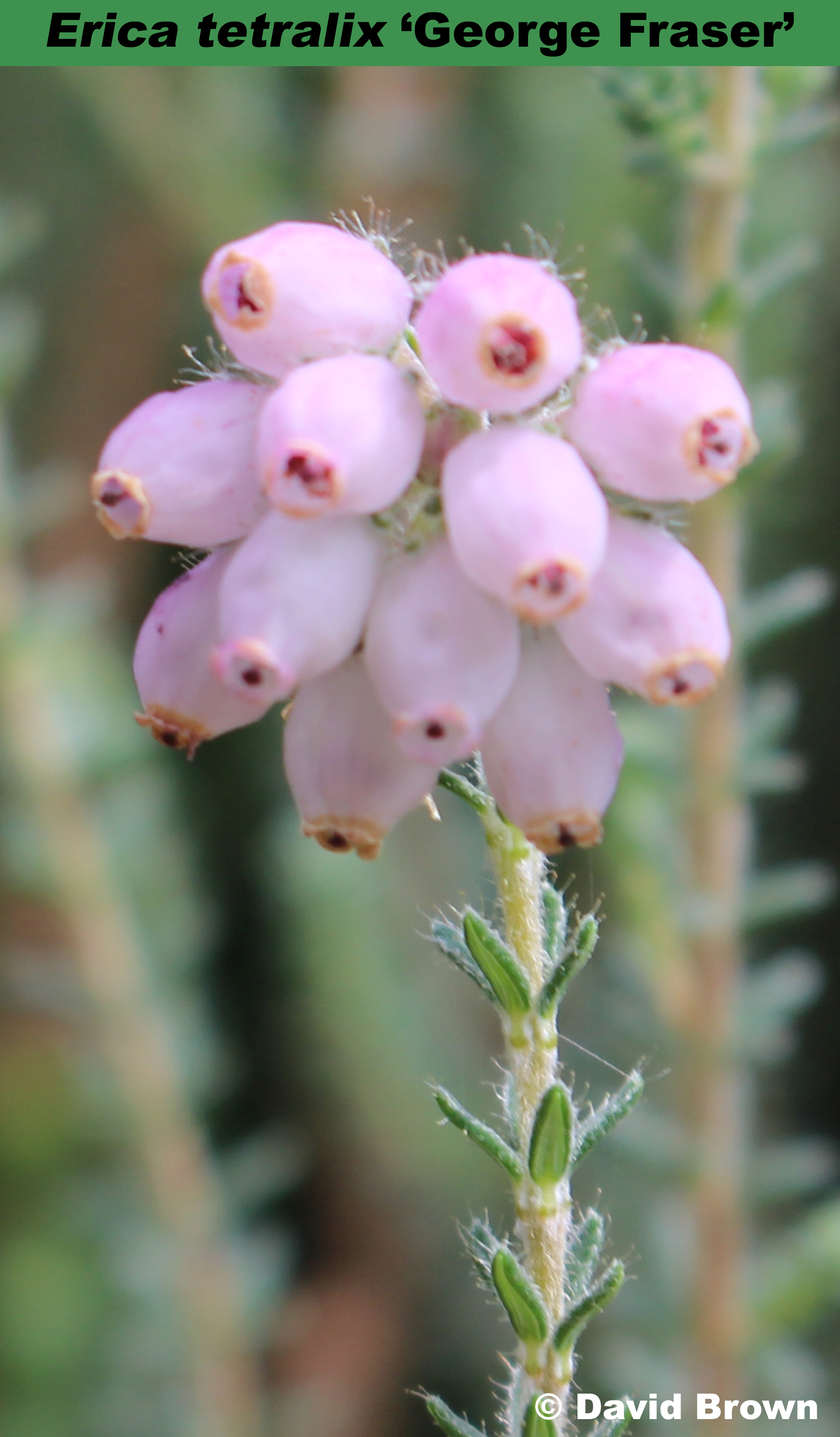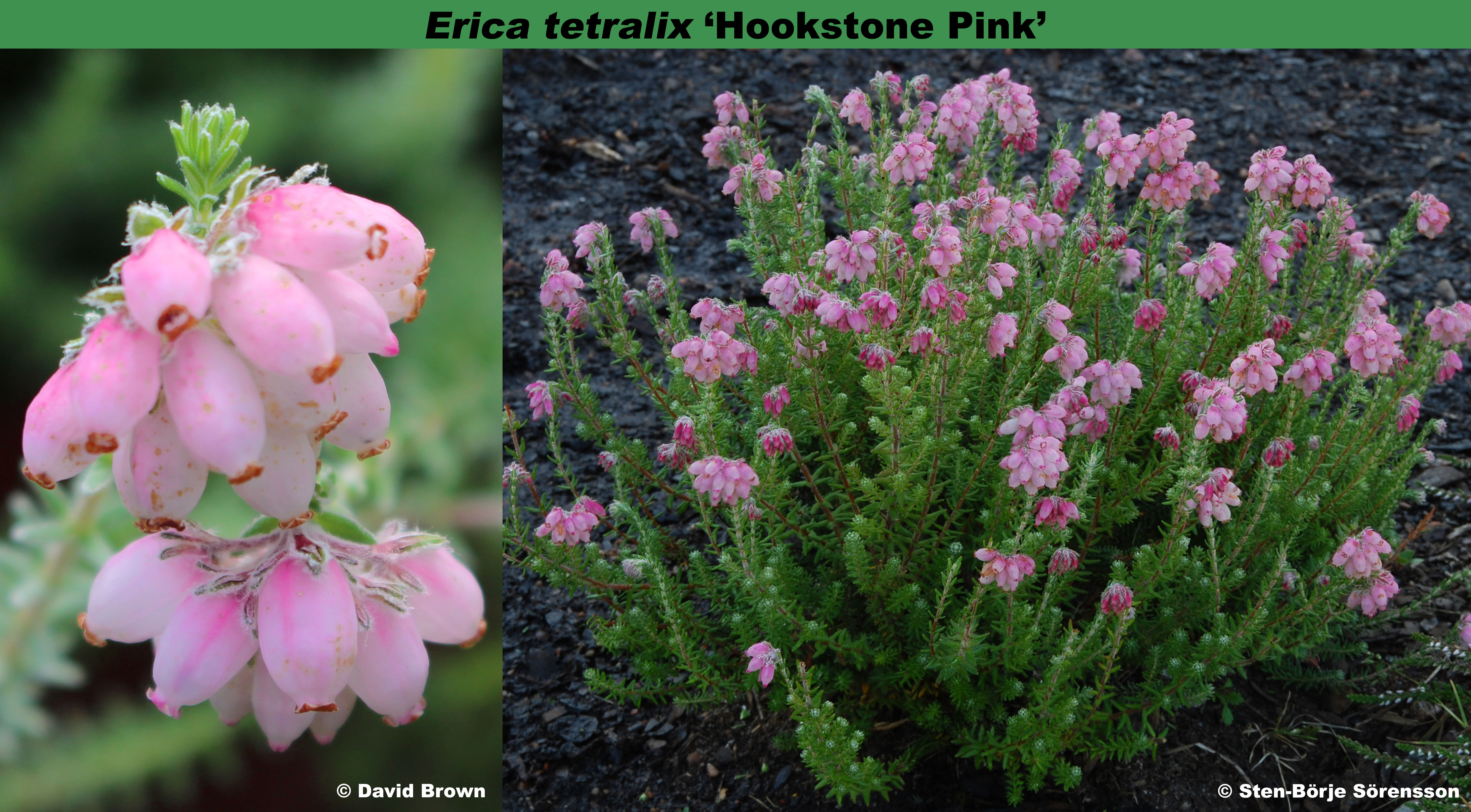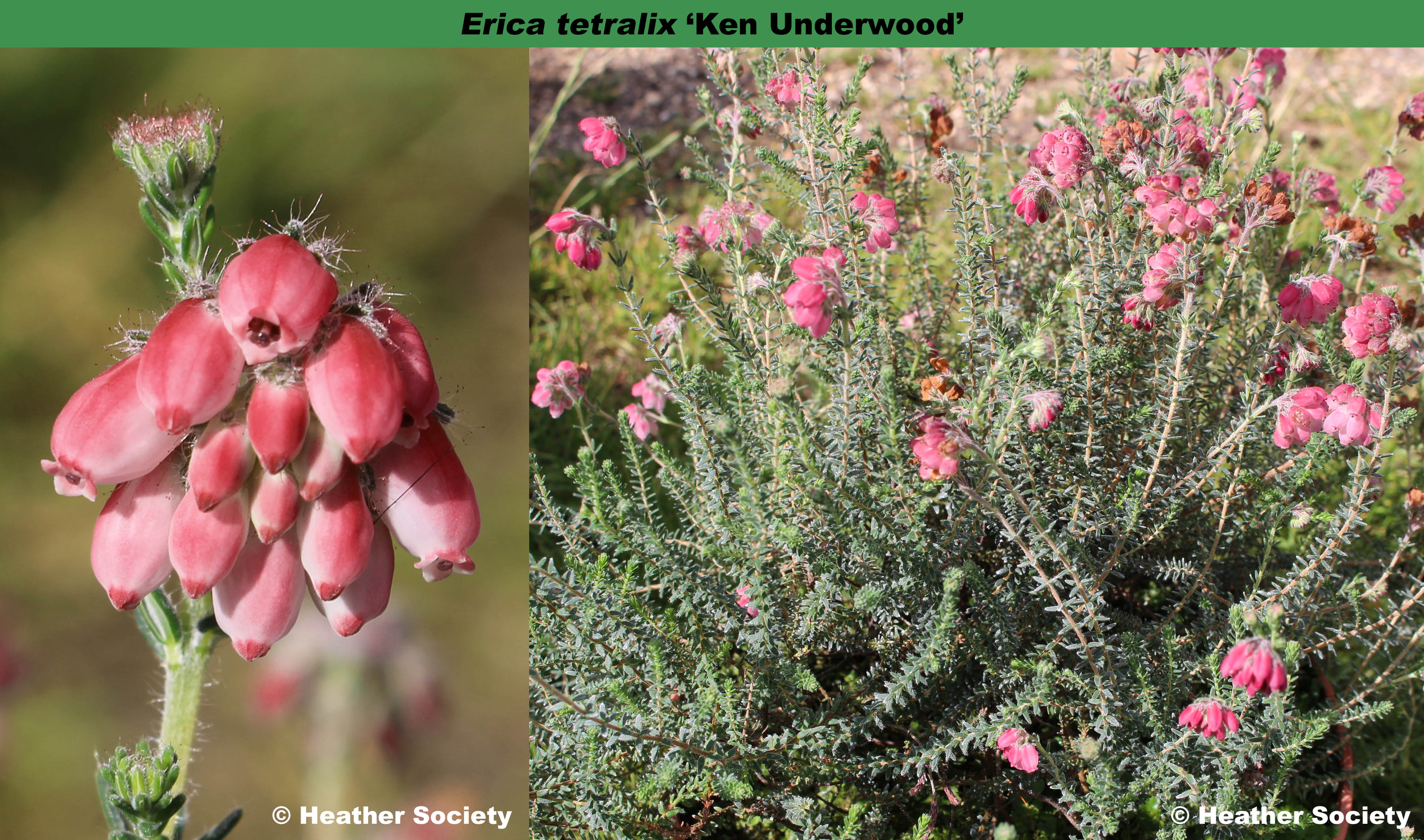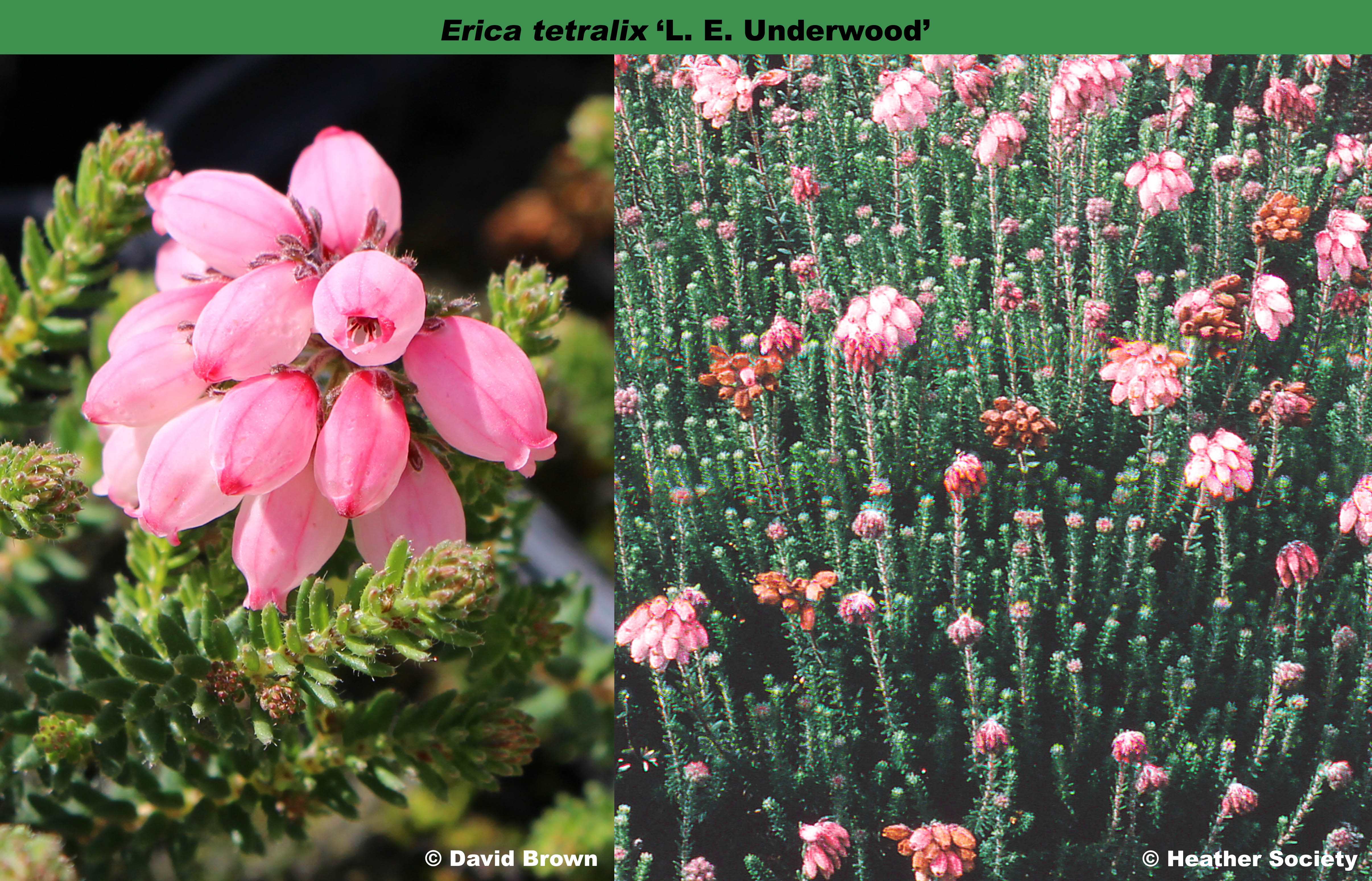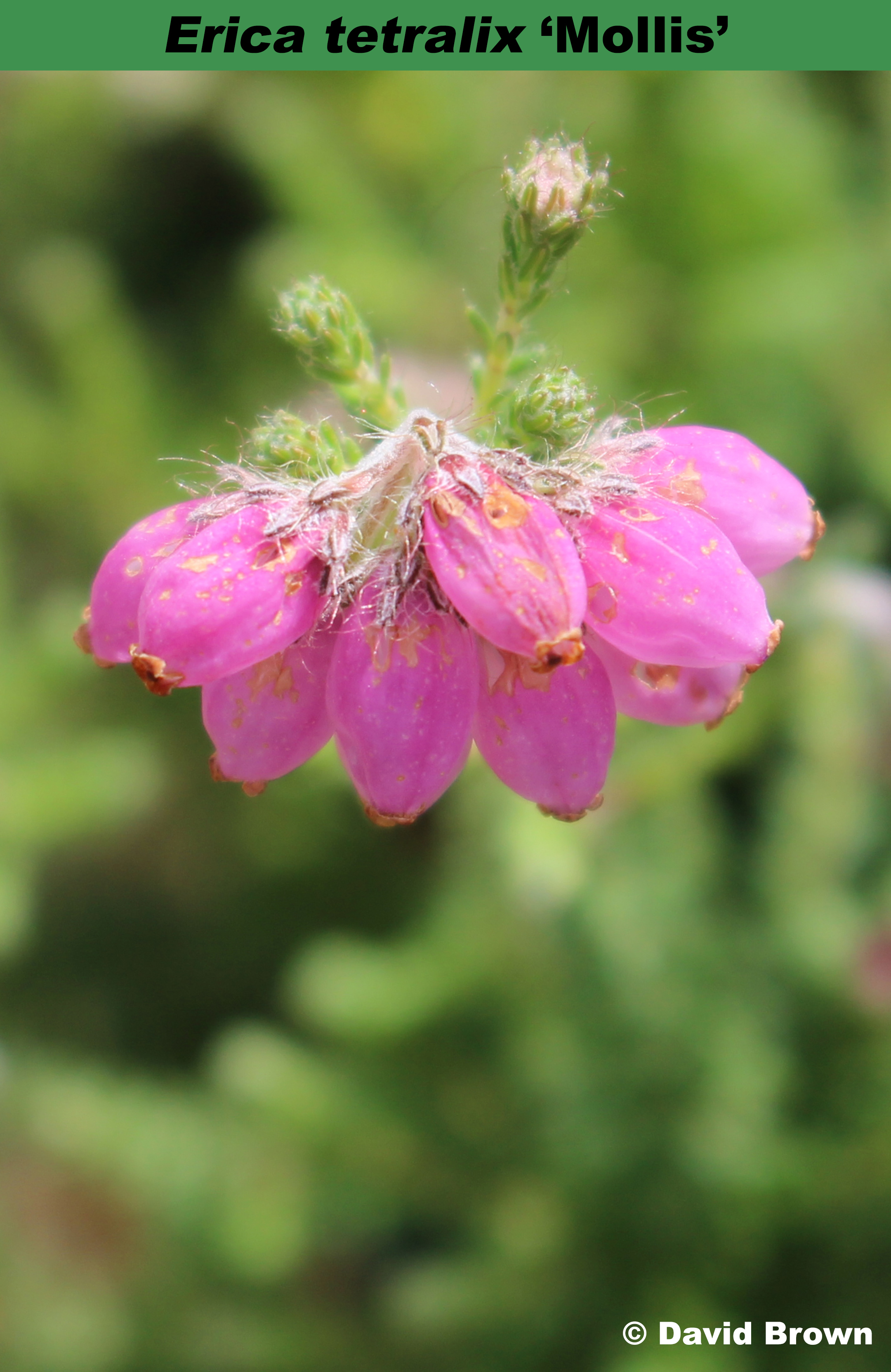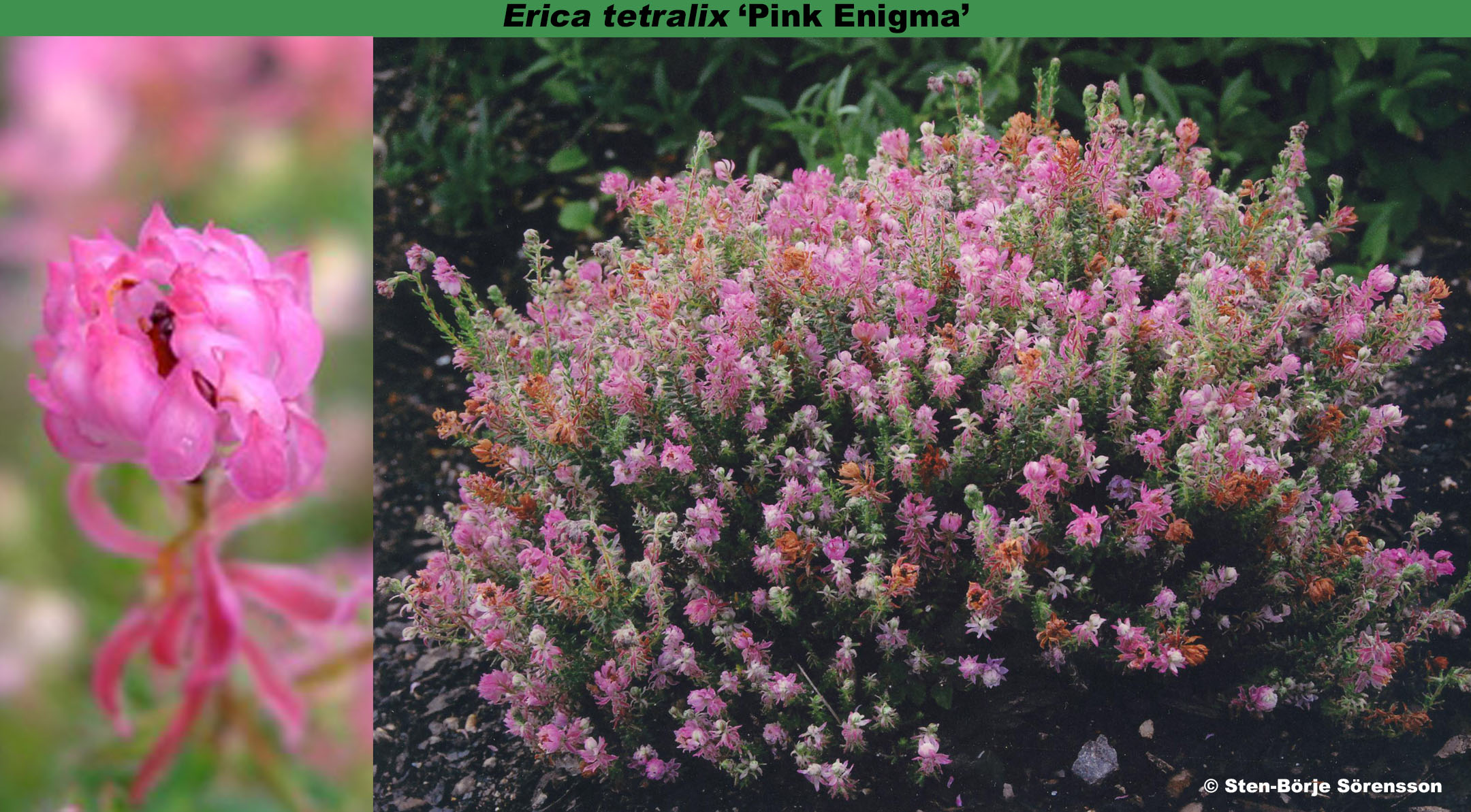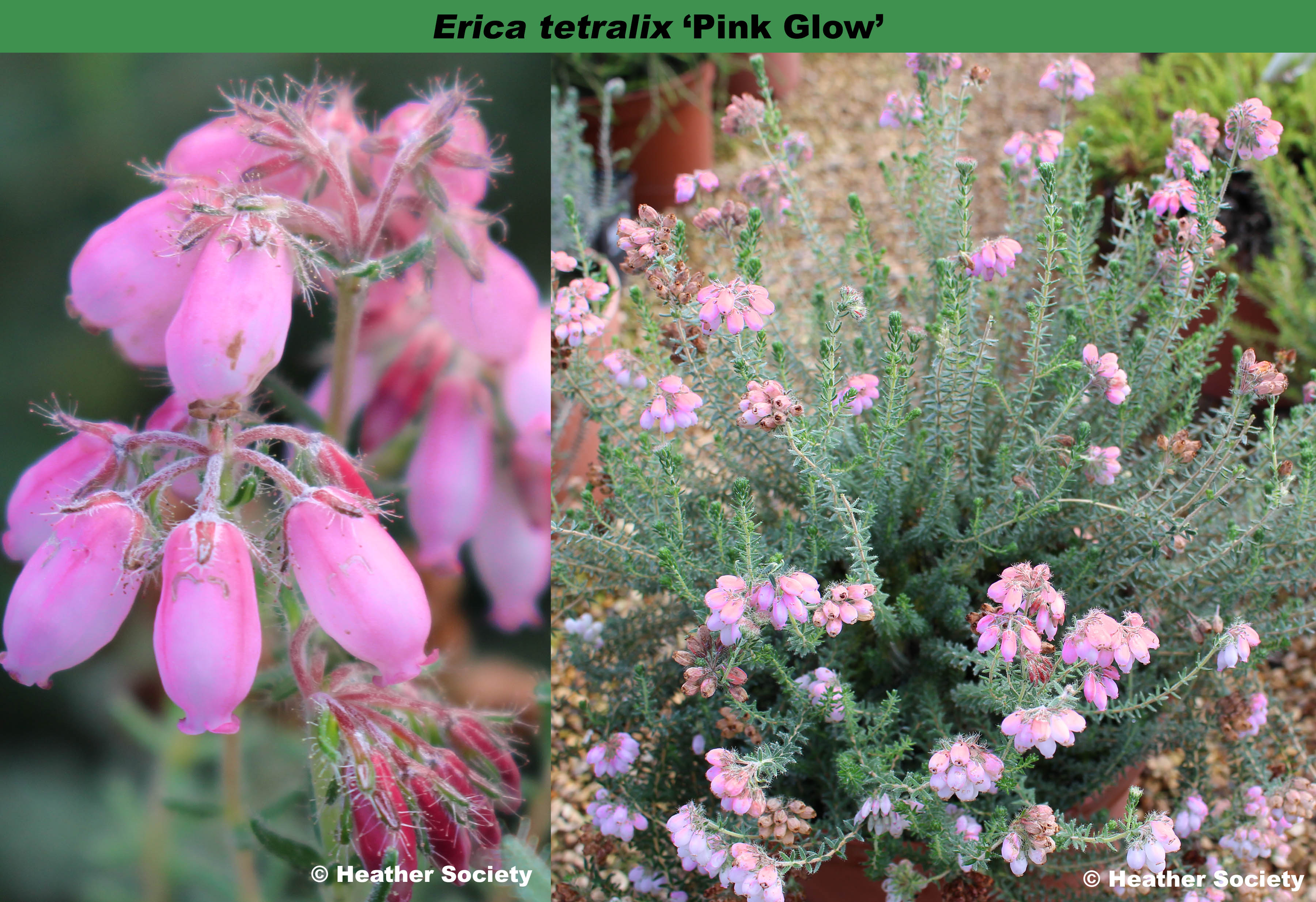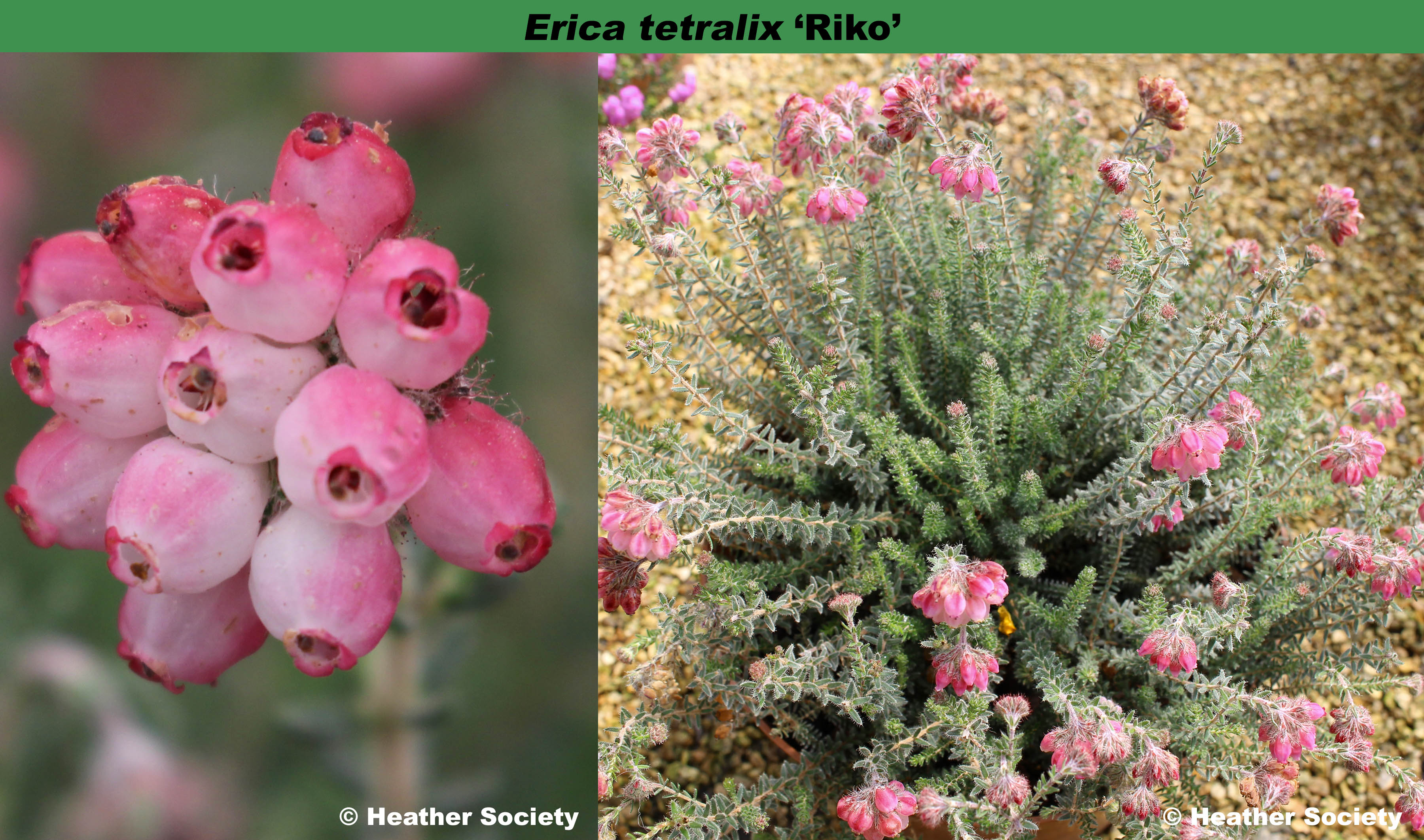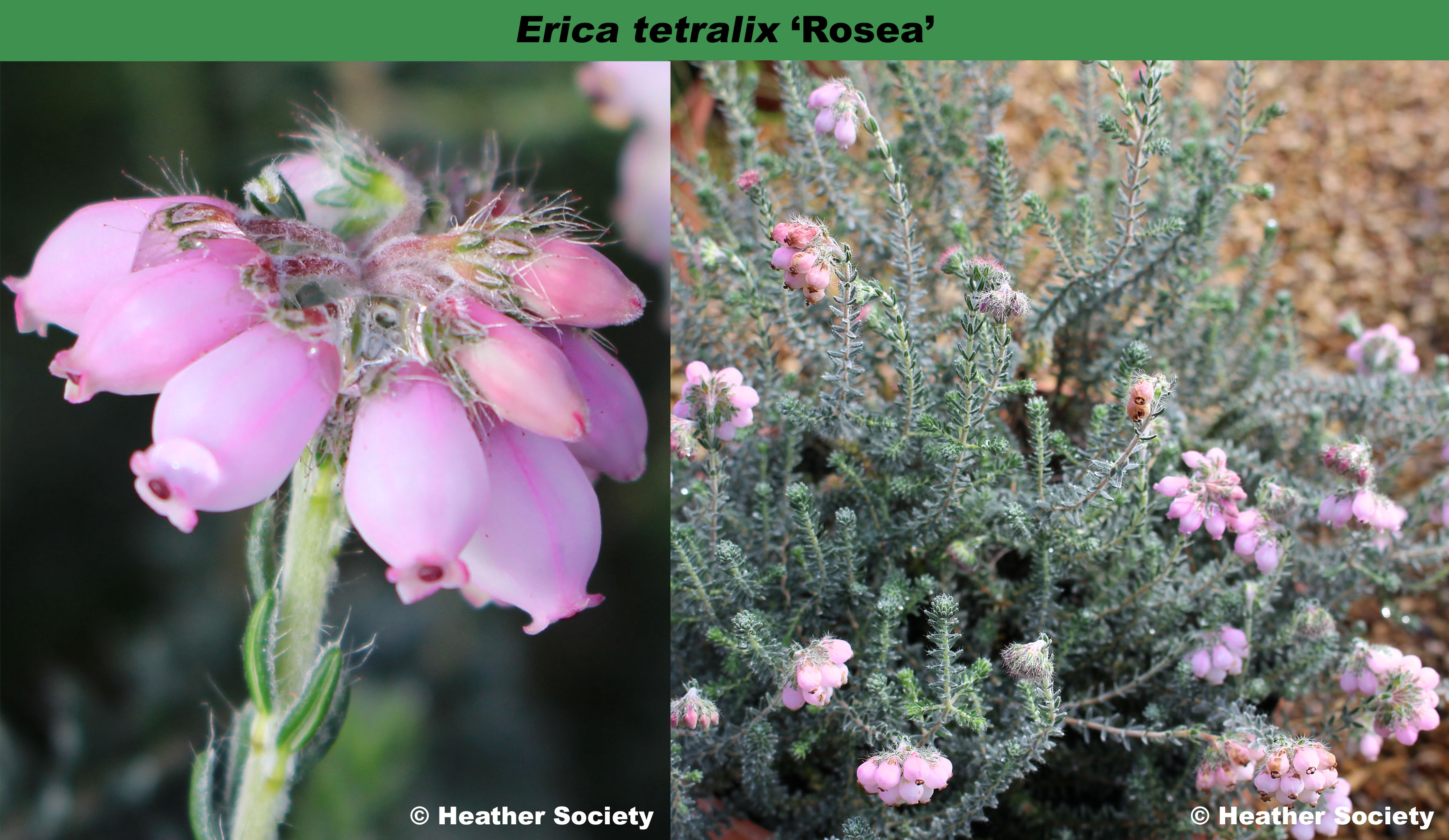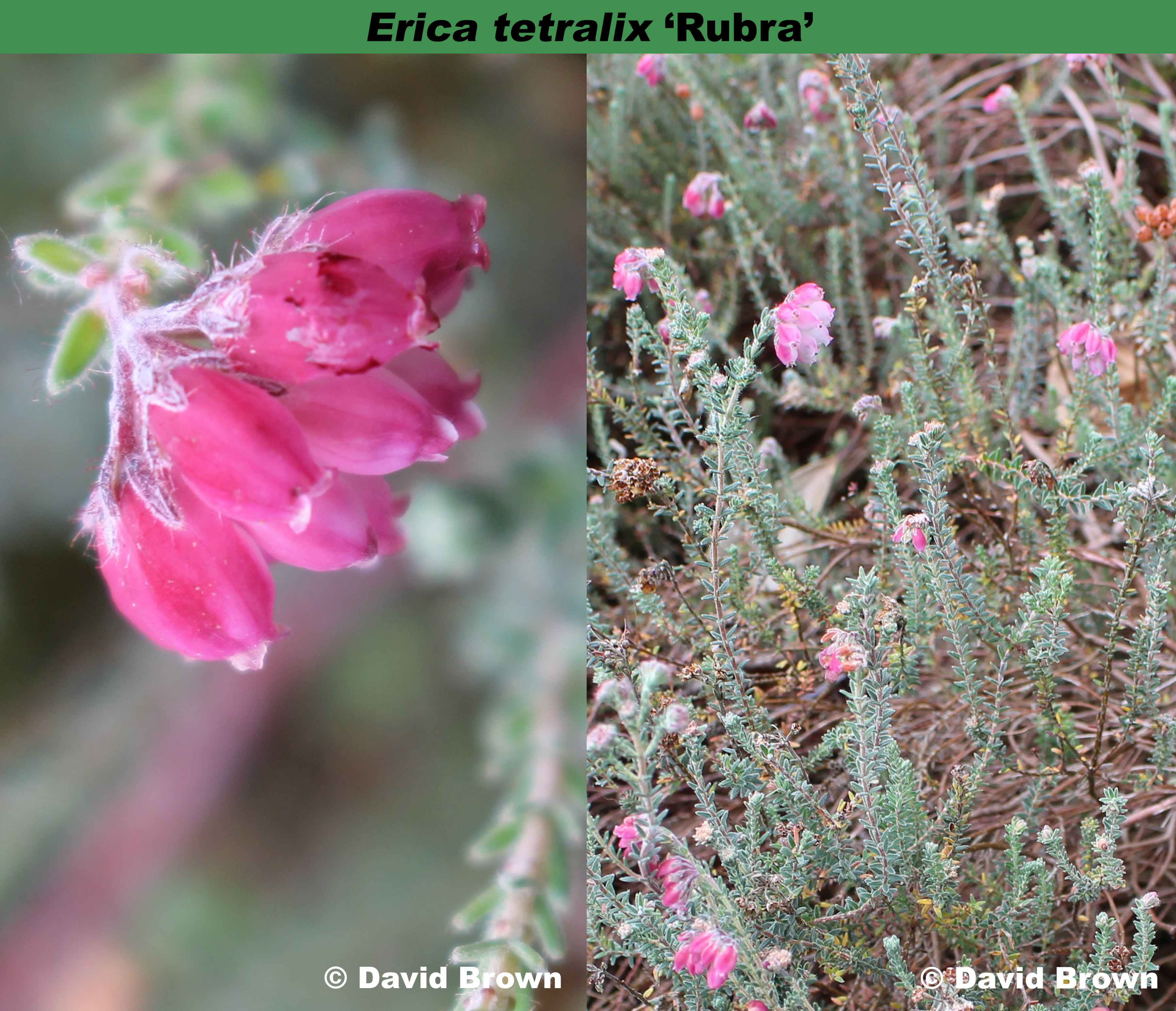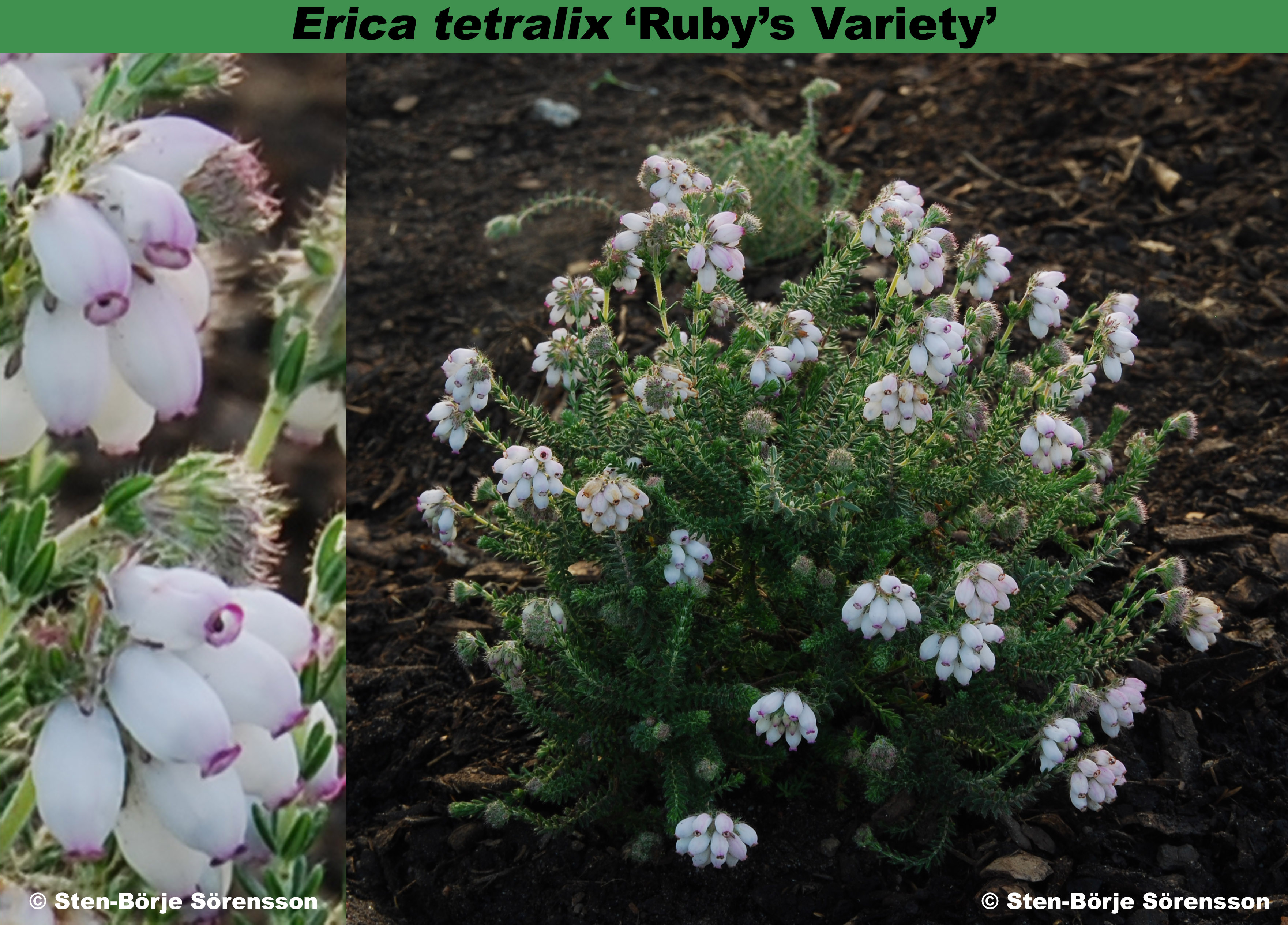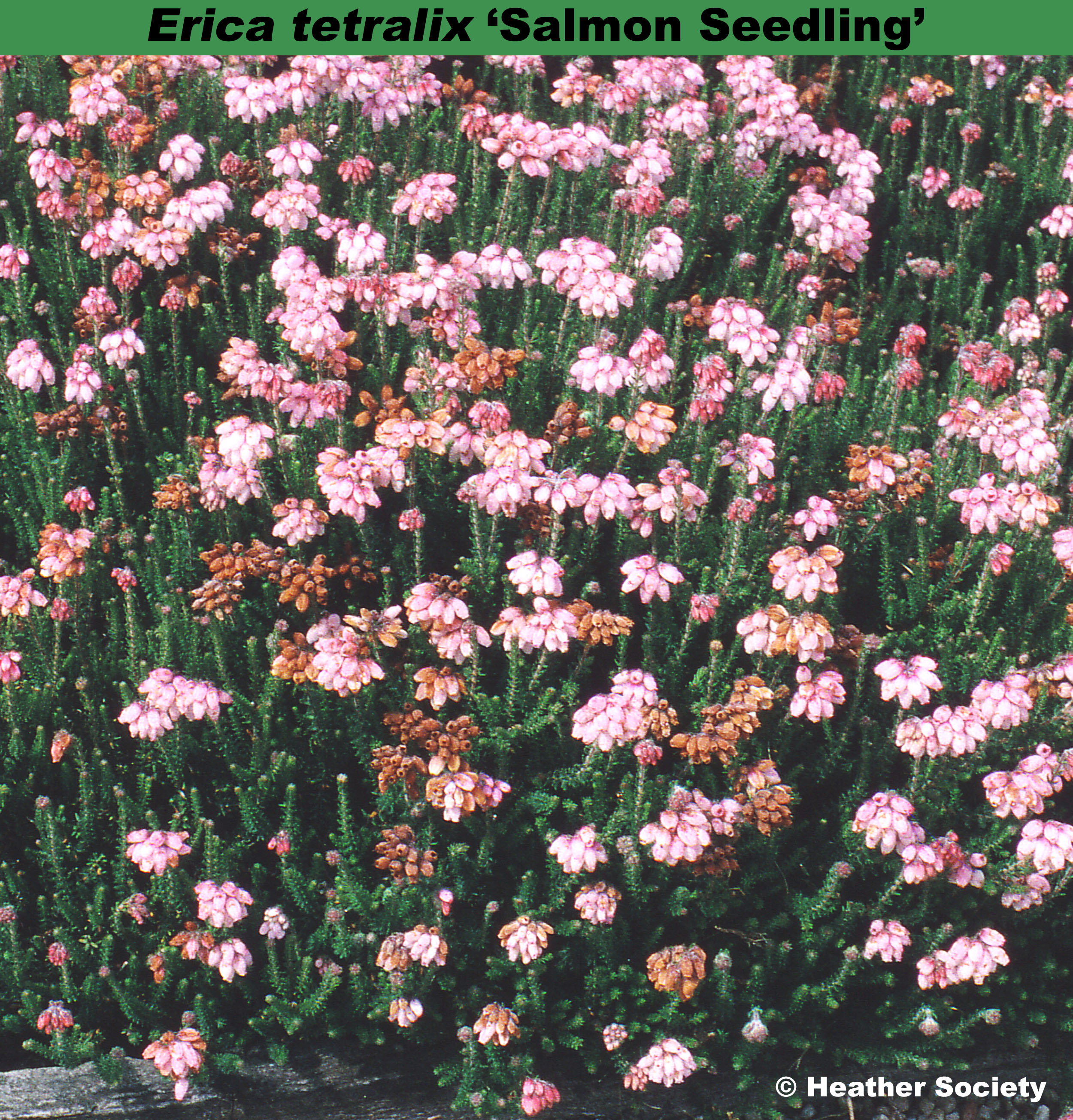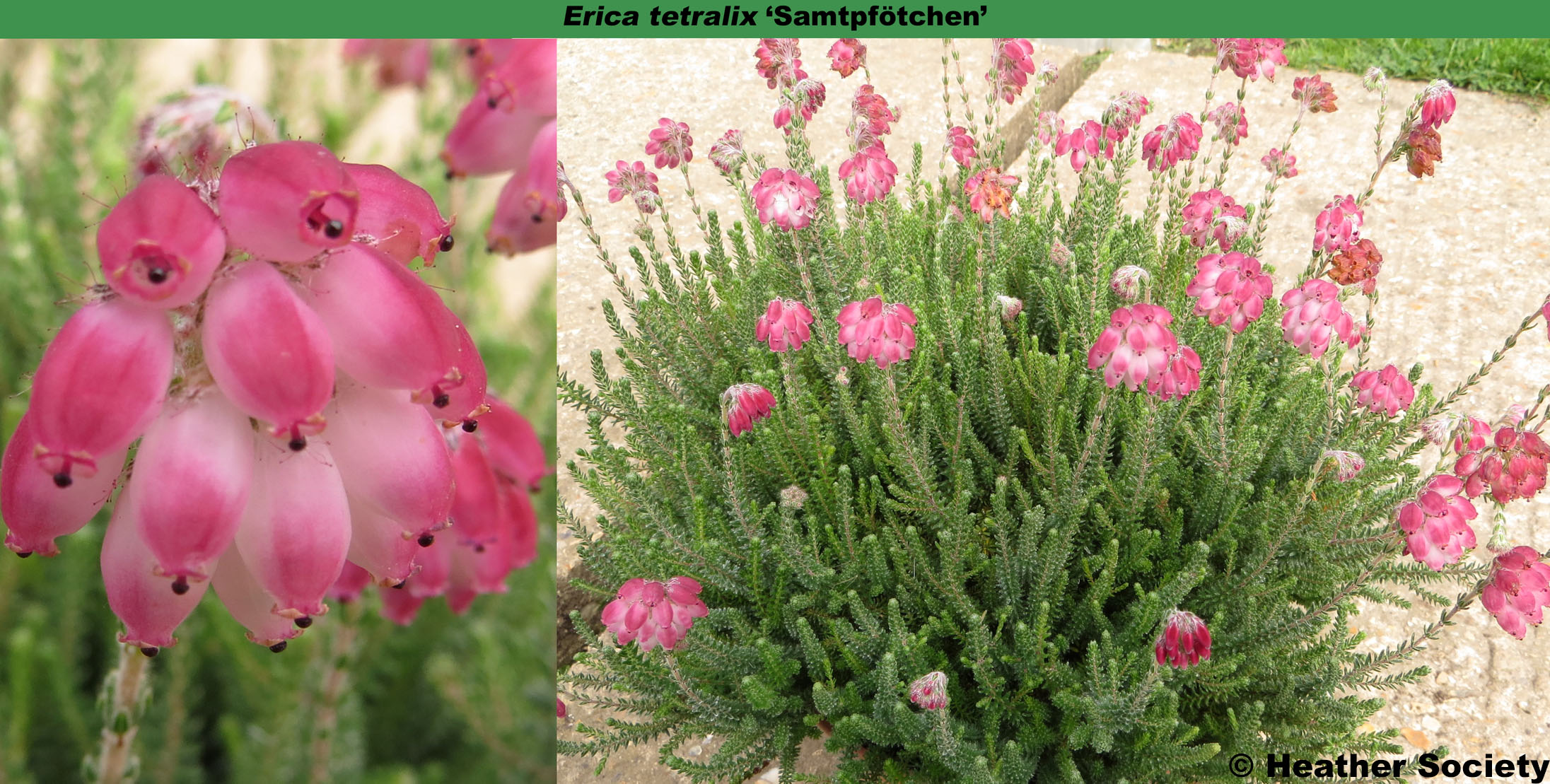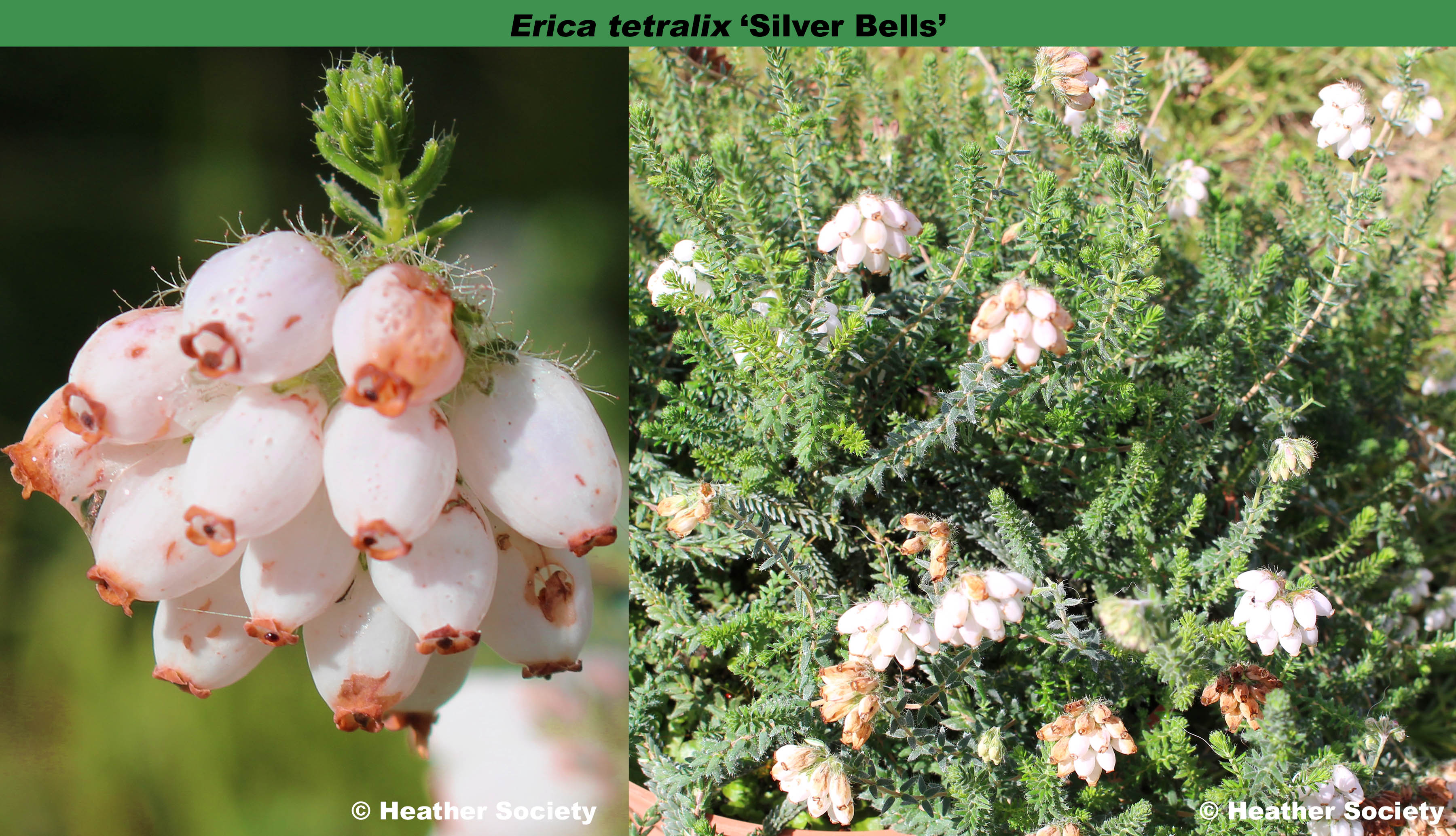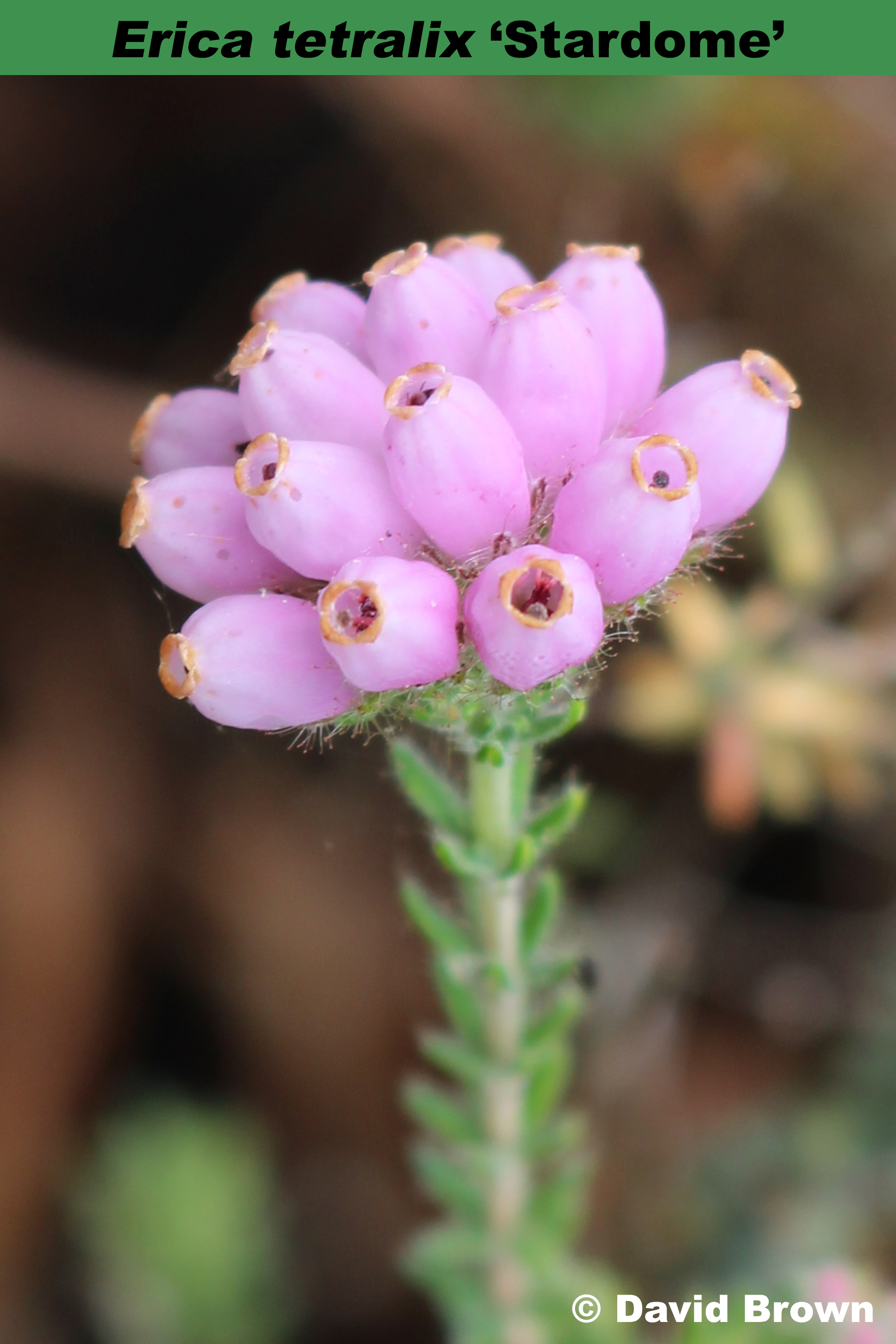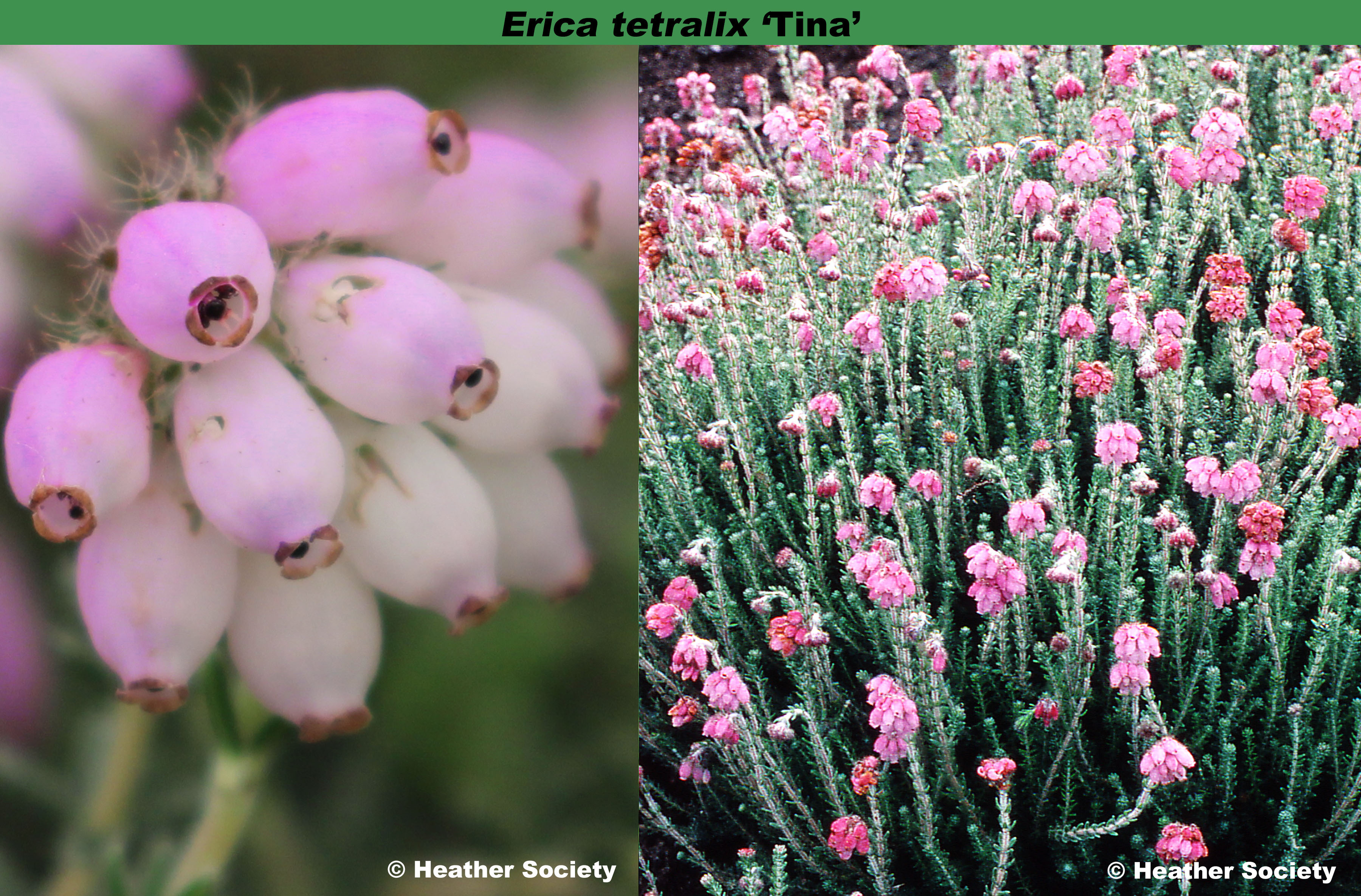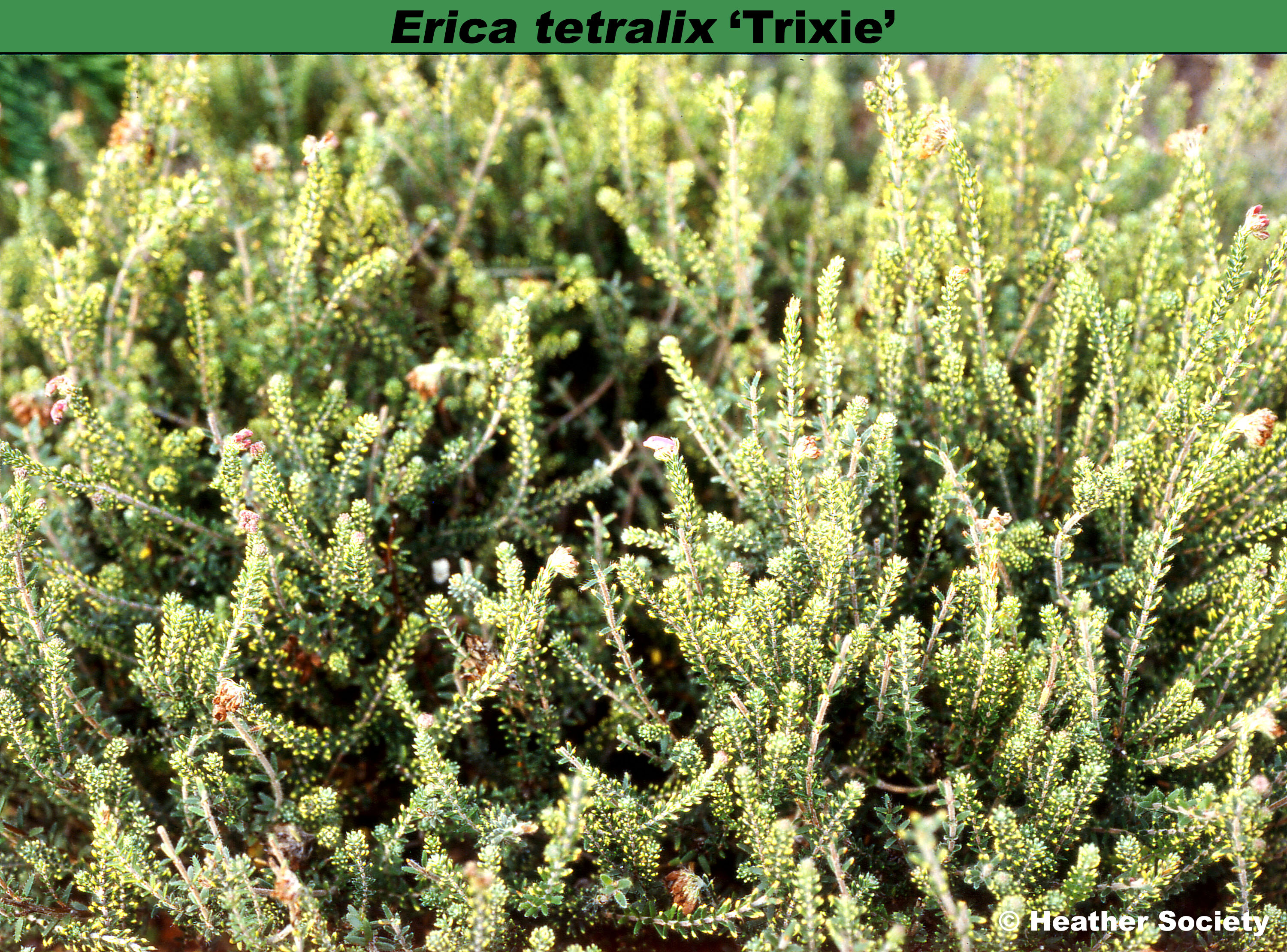Pink flowers, VI–IX; grey-green foliage; erect habit; height 26–30cm; spread 31–45cm. Collected on the Orkneys and introduced by Allendale Nurseries (West Midlands).
Erica tetralix f. tetralix : corolla pink in lopsided umbels
‘Ardy’
Deep pink-red flowers, VI–VIII; dark grey-green foliage; broad erect habit; height 21–25cm; spread 31–45cm.
Sport on ‘Daphne Underwood‘; found by H. J. van de Laar (Boskoop, Netherlands) in 1968; introduced by P. G. Zwijnenburg (Boskoop) in 1974. The flowers are smaller but are the reddest in the species.
Named after the finder’s daughter, Ardy van de Laar (Ericultura 60: 19 (1986)).
‘Arriba’
Flowers large, 0.7 cm long, amethyst above (HI), paler underneath, with prominent ruby (H5) recurved lobes, about 10 in each large cluster; VII-VIII; foliage grey-green. Leaves to 0.5cm long, to 0.2 cm broad at base, obovate, tapering gradually towards tip, with numerous long, glandular cilia, and woolly short hairs on upper side, margins not fully recurved so that lower surface is visible (sinus about 0.1cm wide), lower surface white; young shoots appearing white, covered with woolly short hairs and long cilia; older shoots tinged pink, later pale brown; habit bushy, upright plant; height will probably reach over 0.5m tall if not trimmed.
Collected by D. McClintock, E. C. Nelson and D. J. Small at Brandonas de Arriba, northwest of Santiago de Compostela, La Coruna, Spain, in July 1982. Registered 7 November 1998: E. C. Nelson, Tippitiwitchet Cottage, Hall Road, Outwell, Wisbech, Cambridgeshire, PE14 8PE, England.
‘Bala’
Rose-pink (H7) flowers, VI–IX; grey-green foliage; height 21–25cm; spread 31–45cm. Similar to ‘Hookstone Pink’ but blooms a little earlier. Found by Lake Bala, Wales.
‘Con Underwood’
Magenta (H14) flowers, VII–XI; grey-green foliage; height 21–25cm; spread 46–60cm.
Wild-collected; found in Aldershot area by Mrs C. Underwood (Woking, Surrey, England) in 1938; removed to the nursery where it survived, and introduced by G. Underwood & Son (Hookstone Green Nursery, West End, Woking, Surrey) in 1948.
Named after the finder, the wife of George Underwood (see Erica vagans ‘George Underwood‘).
‘Curled Roundstone’
Pale pink flowers, VI–X; grey-green foliage; prostrate with curling stems, but some may grow upright; height 10–15cm; spread 31–45cm. An interesting novelty, suitable for troughs, window boxes and hanging baskets, collected by Dr Charles Nelson, near Roundstone, County Galway, Ireland.
‘Dänemark’
Bright rose flowers, VII–X; grey-green foliage; low bushy habit; height 10–15cm; spread 31–45cm. Collected south of Hwidesande, on west coast of Denmark.
‘Daphne Underwood’
Deep shell-pink (H16/H10) flowers, VI–IX; grey-green foliage; compact habit; height 16–20cm; spread 31–45cm.
Wild-collected; found in Cuckoo Hill Valley, Chobham Ridges, Surrey, England, by Mrs C. Underwood (Woking, Surrey) in 1953; introduced by G. Underwood & Son (Hookstone Green Nursery, West End, Woking) by 1960.
Named after the wife of Ken Underwood.
‘Darleyensis’
Pale rose-pink (H7) flowers, VII–X; grey-green foliage; very distinctive habit of curled and crossed stems; height 10–15cm; spread 31–45cm.
Found by James Smith (Darley Dale, Derbyshire, England); introduced by James Smith in 1936.
Named from Darley Dale.
‘Delta’
Rose-pink (H7) flowers, VII, very sparse; grey-green foliage; dwarf and compact; height 10–15cm; spread 16–20cm. Useful as a trough plant. Named after the Greek letter ‘delta’ often used to depict small incremental stages.
‘Foxhome’
Cerise (H6) flowers, VI–X; grey foliage; particularly neat, compact habit; height 26–30cm; spread 46–60cm.
Found at Foxhome near Whaley Bridge, Derbyshire, England, by F. J. Chapple about 1960.
Named after the home of a Dr Fuchs.
‘George Fraser’
Pale pink (H8) flowers, VI–IX; olive-green foliage; erect habit; height 21–25cm; spread 26–30cm.
Introduced in USA by 1967, and perhaps associated with a nurseryman of this name who lived at Ucluelet, Vancouver Island, British Columbia, Canada.
Named sfter George Fraser (1854-1944) of Ucluelet was born in Scotland. His surname is spelled with s not z.
‘Gratis’
Pink flowers, VI–IX; light grey-green foliage; bushy; height 16–20cm; spread 26–30cm. Of North American origin.
‘Hookstone Pink’
Rose pink (H7) flowers, VI–X; grey-green foliage; height 16–20cm; spread 31–45cm. Flowers and foliage make a good combination.
Wild-collected; found on High Curley, Bagshot, Surrey, England, by Mr & Mrs G. Underwood in 1953; introduced by G. Underwood & Son (Hookstone Green Nursery, West End, Woking, Surrey) by 1960.
Named after the Underwoods’ nursery, and the flower colour.
‘Jos’s Creeping’
Soft pink (H8) flowers, VI–IX; green foliage, turning grey-green in winter; prostrate; height less than 10cm; spread 26–30cm. Collected in 1985 near Ploumanach, Brittany, France, by Jos Flecken (Kerkrade, Netherlands). Registered 23 December 1993: J. G. Flecken, Kerkrade, Netherlands.
‘Ken Underwood’
Deep salmon (H15) flowers, VI–X; dark grey-green foliage; height 16–20cm; spread 31–45cm. An unusually attractive plant.
Wild-collected; found in Cuckoo Valley, Chobham Ridges, Surrey, England, by K. Underwood in 1951; introduced by G. Underwood & Son (Hookstone Green Nursery, West End, Woking, Surrey) by 1960.
Named after Ken Underwood, the son of the nurseryman George Underwood.
‘L. E. Underwood’
Cerise (H6) flowers, VI–IX, the buds are salmon-coloured; grey-green foliage; height 16–20cm; spread 31–45cm.
Wild-collected; found near West End, Woking, Surrey, England, about 1937; introduced by G. Underwood (Hookstone Green Nursery, West End, Woking, Surrey) by 1951.
Named after George Underwood’s brother, Leslie.
‘Mollis’
Flowers pink; VI-IX; foliage grey; habit upright; height 30cm; spread 30cm.
In cultivation by 1874.
Named from mollis = soft
‘Pink Enigma’
Bushy dwarf shrub with upright shoots; foliage dark greyish-green; leaves usually in fours, broad, ovate, with a few long marginal cilia, sometimes with red-glandular tips especially those towards the apex of a shoot, otherwise upper surface glabrous, margins recurved, lower surface exposed, whitish green; leaves towards the tips of “abnormal” shoots may have pink tips or varying and increasing amounts of pink tissue resembling that of the corolla; in extreme examples, the upper portion of the shoots have no green leaves but have variously shaped pink, petaloid “bracts” which are longer and broader than the leaves; flowers may be formed and seem “normal”, or the flowers are grotesquely malformed; VII-IX. On shoots with flowers, leaves arranged in evenly spaced whorls of four, spreading, but becoming more widely spaced below inflorescence and also tending to become more erect and more appressed to the stem; flowers with densely hirsute ovary.
We do not know where or how this plant originated. Its known history commences when Brita Johansson was given a young plant by Jack Platt who, as past yearbooks show, was a very keen collector of new clones which he cultivated for a few years in his garden before replacing them with newer ones. Platt informed Mrs Johansson that he had obtained the plant from Ray Warner. Brita Johansson grew ‘Pink Enigma’ in her garden in Sweden, propagated it and passed a plant to Sten-Börje Sörensson who still cultivates it. It is apparently very hardy and was not affected by the extremely cold winter of 2010–2011.
® E.2011:01 registered on 17 September 2011 by Brita Johansson, Vargon, Sweden.
‘Pink Glow’
Magenta (H14) flowers, VI–IX, which fade as they age giving a bi-colour effect; grey-green foliage; neat habit; height 16–20cm; spread 31–45cm.
Introduced by Maxwell & Beale (Broadstone, Dorset, England) by 1927.
Name alludes to the flower colour.
‘Pink Pepper’
Pink flowers, VII–IX; grey-green foliage with white speckling; compact, slow growing; height 10–15cm; spread 26–30cm. An unusual plant; found at the RHS Gardens, Wisley, Surrey.
‘Riko’
Ruby (H5) flowers, VI–VIII; grey-green foliage; compact; height 21–25cm; spread 31–45cm. This has the darkest flowers of any Erica tetralix cultivar.
A seedling from ‘Tina‘ raised by Lothar Denkewitz (Hamburg, Germany) in 1991. ‘Samtpfötchen‘ is a sister-seedling.
Named after a grandson of Lothar Denkewitz.
‘Rosea’
Lilac-pink (H11) flowers, VII–IX; light green foliage; height 21–25cm; spread 31–45cm. One of the better cross-leaved heaths for flower although the colour is rather muddy.
A very old cultivar sent by G. Donn to Mr Cruikshank of Langley Park, Scotland, 4 October 1813.
‘Rubra’
Carmine flowers, VII–IX; grey-green foliage; bushy, compact habit; height 16–20cm; spread 26–30cm.
Named after the latin ruber = red
‘Ruby’s Variety’
Off-white flowers with ruby tips, VI–X, fading to salmon; grey-green foliage; neat spreading habit; height 21–25cm; spread 31–45cm.
Wild-collected; found in Dorset, England, by Miss R. Beale in 1920; introduced by Maxwell & Beale (Broadstone, Dorset) in 1921.
Named after Miss Ruby Beale, the finder, and not a references to the colour of the flowers.
‘Salmon Seedling’
Rose-pink (H7) flowers, VI–IX; grey-green foliage; compact erect habit; height 16–20cm; spread 26–30cm.
Introduced by Grovemount Alpine Nursery, Auchterader, Scotland, by 1972.
Name may allude to the flower colour.
‘Samtpfötchen’
Dusky rose-pink flowers, VII–VIII; grey-green foliage; height 21–25cm; spread 31–45cm.
Seedling from ‘Tina‘ raised by Lothar Denkewitz (Hamburg, Germany); introduced by L. Denkewitz in 1991. Like ‘Riko‘ this arose from an intended (but unsuccessful) cross between Erica cinerea ‘Pink Ice‘ and Erica tetralix ‘Tina‘.
The name refers to the velvety corolla.
‘Silver Bells’
Very pale shell-pink (H16) flowers, VI–X; grey-green foliage; erect; height 26–30cm; spread 31–45cm. A new-comer which promises to be a stayer, which is almost unique in its colour, an ashen-white delicately flushed with silvery rose.
Introduced by T. Smith & Sons, Daisy Hill Nursery (Newry, County Down, Northern Ireland) about 1929.
Name alludes to the flowers.
‘Stardome’
Very pale rose-pink flowers with dark tips, VII–IX; grey-green foliage; compact, erect habit; height 21–25cm; spread 31–45cm.
Commercially available from Barncroft Nurseries (Longsdon, Stoke-on-Trent, Staffordshire, England) by 1987; introduced before 1985.
‘Stikker’
Lilac-pink flower buds held at right angles to the stem but they do not open, turning soft pink and pointing upwards, VI–IX; grey-green foliage; broad erect habit; height 21–25cm; spread 26–30cm. Collected north of Odoorn, Netherlands, and named after a peat-cutting tool.
‘Tina’
Pale purple (H10) flowers, VIII–XI; grey foliage, particularly in winter; broad habit; height 16–20cm; spread 31–45cm.
Wild-collected; found on Kampina Heath between Boxtel and Tilburg, Netherlands, by M. Zwijnenburg (Boskoop, Netherlands) in 1965; introduced by P.G. Zwijnenburg in 1967.
Named after the finder’s daughter.
‘Trixie’
Pale pink flowers, VII–IX; grey-green foliage, leaves with yellow margins; height 16–20cm; spread 21–25cm.
Wild-collected; found by J. Baron at Oosterbos, Emmen, Netherlands, in 1979; named by Mrs Brita Johansson (Vargön, Sweden) in 1991, but introduced as early as 1986 by Herman Blum (Steenwijkerwold, Netherlands).
Named after Queen Beatrix of The Netherlands, following a name competition run by the Swedish gardening society STA.

